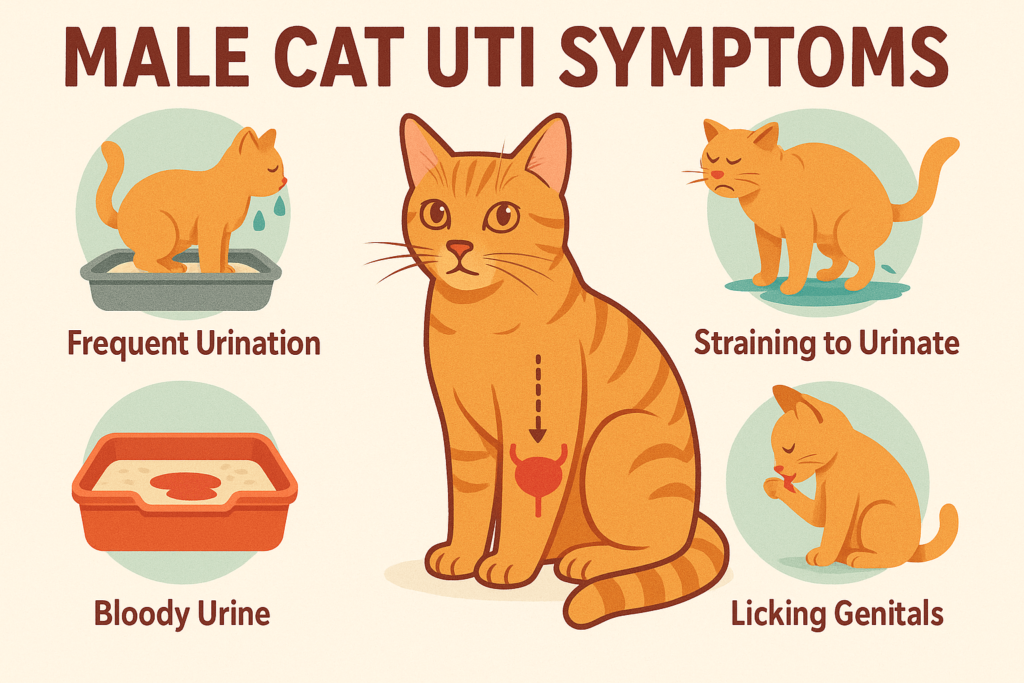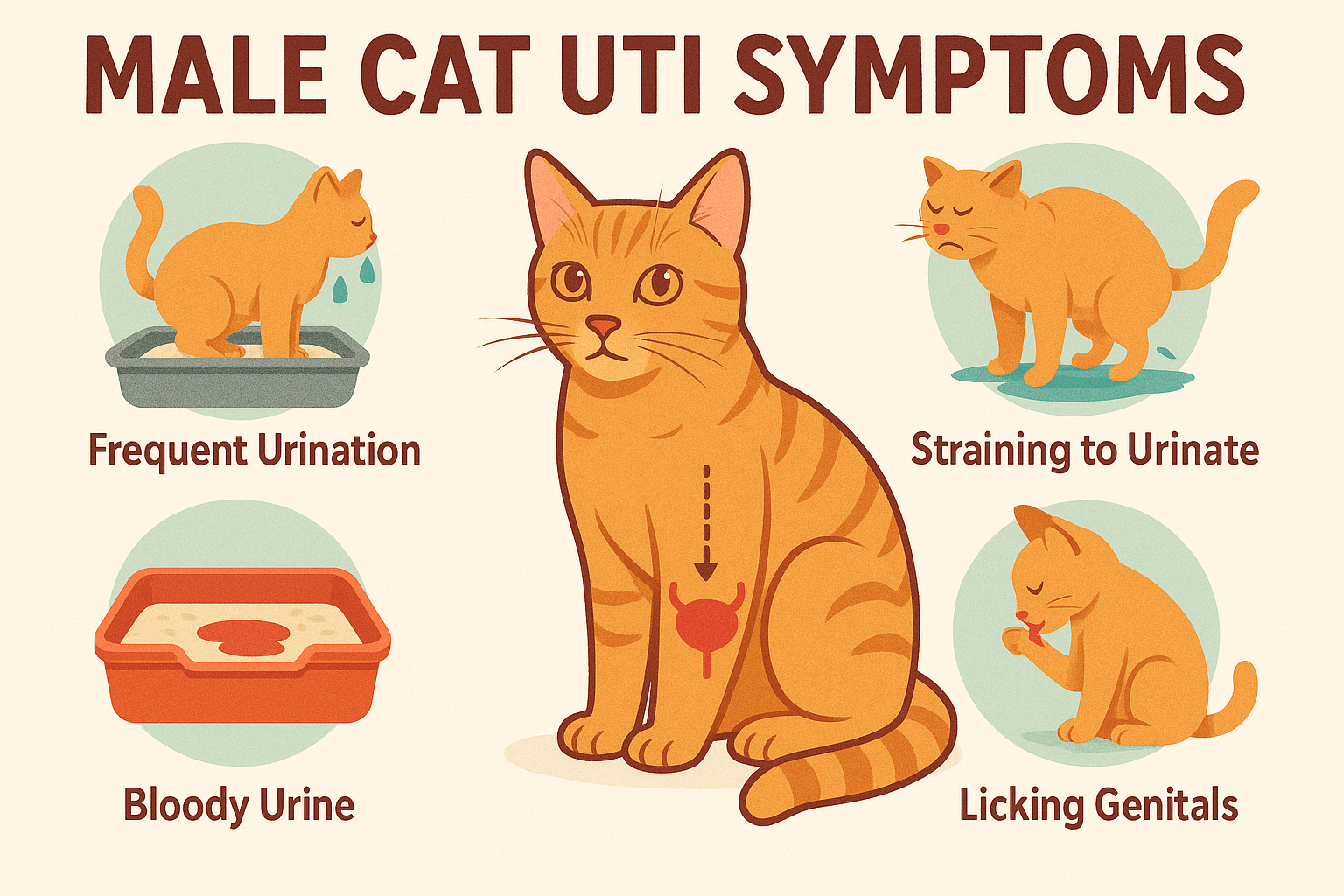Male Cat UTI Symptoms: What Every Cat Owner Should Know
Urinary tract infections (UTIs) and related urinary issues are more common in male cats than you might think. While female cats are generally more prone to UTIs, male cats face unique risks due to their narrower urethra, which can lead to blockages or severe complications if left untreated. Recognizing the symptoms early is crucial for ensuring your feline friend receives prompt care and avoids potentially life-threatening situations. In this blog post, we’ll explore the signs of UTIs in male cats, how to differentiate them from other urinary issues, and what steps you can take to keep your cat healthy and happy.
Expert Insight on Feline UTIs
“In most cases, UTIs in cats are usually caused by bacteria. Bacterial urinary tract infections in cats are generally relatively easy to treat and respond well to medications. Chronic infections, or those that do not respond to regular medication, can require more testing to figure out why your cat is at higher risk for urinary tract infections.”
Common Male Cat UTI Symptoms to Watch For
Identifying the symptoms of a UTI in your male cat is the first step toward getting them the care they need. These signs may vary in severity but should never be ignored.
Frequent Attempts to Urinate:
Your cat may visit the litter box more often than usual but produce little to no urine. This behavior indicates discomfort or difficulty urinating.Straining or Crying While Urinating:
If your cat appears to be in pain or vocalizes while using the litter box, it could signal an infection or blockage.Blood in Urine:
Pink, red, or discolored urine is a clear warning sign of a urinary issue that requires immediate attention.Licking Genital Area Excessively:
Over-grooming around the urinary opening is a common response to irritation or infection.Changes in Behavior:
A normally social cat may become withdrawn, lethargic, or unusually aggressive when dealing with urinary discomfort.
If you notice any of these symptoms, it’s essential to consult your veterinarian promptly to prevent further complications.

How to Differentiate UTIs from Other Urinary Issues
While UTIs are a common concern, male cats can also suffer from other urinary problems, such as bladder stones or urethral obstructions. Understanding the differences helps ensure proper treatment.
Urethral Blockages:
Unlike UTIs, blockages prevent urination entirely and are a medical emergency requiring immediate veterinary intervention.Bladder Stones:
These hard mineral deposits can cause similar symptoms to UTIs but often require imaging tests like X-rays for diagnosis.Feline Lower Urinary Tract Disease (FLUTD):
FLUTD is an umbrella term for various urinary issues, including infections, inflammation, and obstructions, making it harder to pinpoint the exact cause without professional help.Stress-Induced Cystitis:
Stress or environmental changes can irritate the bladder lining, mimicking UTI symptoms even without an actual infection.Kidney Problems:
Kidney disease or infections may present similarly to UTIs but typically involve additional symptoms like increased thirst or vomiting.
Understanding these distinctions ensures your cat receives the appropriate care tailored to their specific condition.
Check this guide 👉Cat Urine High pH: Best 7 Expert Tips!
Check this guide 👉Can Cat Urine Make You Sick? Best 7 Expert Tips!
Check this guide 👉Is Cat Pee Toxic? Best 7 Expert Tips!
Symptoms of Male Cat UTIs | Possible Causes Behind Symptoms |
|---|---|
Frequent attempts to urinate | Bacterial infection or urethral blockage |
Straining or crying during urination | Bladder stones or inflammation |
Blood in urine | Trauma, infection, or kidney issues |
Excessive licking of genital area | Irritation or urinary crystals |
Changes in behavior | Pain, stress, or underlying illness |
Steps to Take if You Suspect a UTI in Your Male Cat
If you suspect your male cat has a UTI or another urinary issue, acting quickly can make all the difference. Follow these steps to ensure your cat gets the care they need.
Contact Your Veterinarian Immediately:
Don’t wait to see if symptoms improve on their own—prompt diagnosis and treatment are critical for your cat’s health.Provide Fresh Water and Encourage Hydration:
Increasing water intake can help flush out bacteria and reduce the risk of complications.Monitor Litter Box Habits Closely:
Keep track of how often your cat uses the litter box and note any unusual behaviors or changes in urine output.Limit Stressful Situations:
Minimize environmental stressors, such as loud noises or sudden changes, as stress can exacerbate urinary issues.Avoid Self-Medicating Your Cat:
Never give your cat over-the-counter medications or treatments without consulting your vet, as they could worsen the condition.
Taking these proactive measures can help alleviate your cat’s discomfort and prevent further health issues.
Preventing UTIs and Urinary Issues in Male Cats
Prevention is always better than cure when it comes to urinary health. These tips can help reduce the risk of UTIs and other urinary problems in your male cat.
Feed a Balanced Diet:
Choose high-quality cat food specifically formulated to support urinary health and prevent crystal formation.Ensure Constant Access to Clean Water:
Encourage hydration by providing fresh, clean water at all times and considering a cat water fountain to entice drinking.Maintain a Stress-Free Environment:
Create a calm and predictable living space to minimize anxiety, which can contribute to urinary issues.Schedule Regular Vet Check-Ups:
Routine veterinary visits allow for early detection and management of potential urinary problems before they escalate.Keep the Litter Box Clean:
A dirty litter box may discourage your cat from urinating regularly, increasing the risk of infections or blockages.
By implementing these preventive measures, you can significantly lower the chances of your cat developing urinary issues.
Signs That Your Cat’s UTI May Be Severe
Some symptoms indicate a more serious urinary issue that requires immediate attention. Recognizing these red flags can save your cat’s life.
Complete Lack of Urination:
If your cat hasn’t urinated in 12-24 hours, it could indicate a life-threatening blockage.Vomiting or Loss of Appetite:
These symptoms suggest toxins building up in the bloodstream due to a blocked urethra.Extreme Lethargy or Weakness:
Unusual fatigue or inability to move may signal advanced stages of urinary distress.Swollen Abdomen:
A distended belly could mean urine retention and requires urgent veterinary evaluation.Aggressive Behavior When Touched:
Pain-induced aggression is a sign your cat is suffering and needs immediate care.
Acting quickly upon noticing these signs can prevent irreversible damage or death.
Home Remedies to Support Urinary Health
While professional treatment is essential, there are ways to support your cat’s urinary health at home. These remedies complement veterinary care but shouldn’t replace it.
Increase Water Intake:
Add water to dry food or switch to wet food to boost hydration levels naturally.Use Herbal Supplements (with Vet Approval):
Certain herbs, like cranberry extract, may support urinary tract health under veterinary guidance.Provide Multiple Litter Boxes:
Offering several clean litter boxes reduces stress and encourages regular urination.Incorporate Playtime:
Regular exercise promotes overall health and reduces stress-related urinary issues.Create a Calm Environment:
Use pheromone diffusers or calming music to soothe anxious cats and minimize triggers.
These strategies enhance your cat’s well-being and aid in recovery after treatment.
Understanding Diagnostic Tests for Male Cat UTIs
Veterinarians use various diagnostic tools to identify the root cause of urinary issues in male cats. Understanding these tests helps demystify the process and ensures informed decisions about treatment.
Urinalysis:
Analyzing a urine sample checks for bacteria, blood, crystals, or abnormal pH levels.Ultrasound Imaging:
Ultrasounds reveal structural abnormalities, such as bladder stones or tumors, that may contribute to symptoms.X-Rays:
Radiographs help detect bladder stones or other foreign objects obstructing the urinary tract.Blood Tests:
Bloodwork identifies systemic issues, such as kidney disease or infections, affecting urinary function.Culture and Sensitivity Testing:
This test determines the specific bacteria causing the infection and the most effective antibiotic for treatment.
These diagnostics ensure accurate identification and targeted treatment of your cat’s urinary problem.
Frequently Asked Questions About Male Cat UTIs
Can male cats recover from a UTI on their own?
No, untreated UTIs can worsen and lead to serious complications like blockages. Always seek veterinary care for proper treatment.
How long does it take to treat a UTI in cats?
Most UTIs resolve within 7-10 days with antibiotics and supportive care, but recovery time depends on the severity of the infection.
What foods help prevent UTIs in male cats?
Wet food and specially formulated urinary diets promote hydration and reduce the risk of crystal formation.
Are UTIs contagious between cats?
No, UTIs caused by bacterial infections are not contagious, but addressing hygiene and shared resources can prevent cross-contamination.
What should I do if my cat stops urinating completely?
A complete lack of urination is a medical emergency. Take your cat to the vet immediately to address potential blockages.
Prioritizing Your Male Cat’s Urinary Health
Recognizing and addressing male cat UTI symptoms early is vital for preventing complications and ensuring your furry companion stays healthy. By staying vigilant, understanding the signs, and taking preventive measures, you can provide your cat with the best possible care. Remember, your vet is your greatest ally in managing urinary issues, so don’t hesitate to reach out whenever you have concerns. With love, attention, and proactive care, you can help your male cat enjoy a happy, comfortable life free from urinary troubles.
Understanding Cryptosporidium in Cats: Best 7 Expert Tips! – Spot symptoms, treat safely, and stop parasite spread in your home.
Understanding Cryptosporidium in Dogs: Best 7 Expert Tips! – Learn symptoms, treatment & prevention for this stubborn gut parasite.
Understanding Syringomyelia in Cats: Best 7 Expert Tips! – Recognize signs, manage pain, and support your cat’s neurological health with vet-backed guidance.
Understanding Syringomyelia in Dogs: Best 7 Expert Tips! – Expert insights on symptoms, MRI diagnosis, pain management & quality of life.





